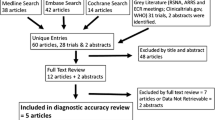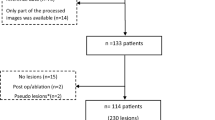Abstract
Purpose
To investigate the diagnostic performance of dual-layer dual-energy CT (dlDECT) in the evaluation of adrenal nodules.
Methods
In this retrospective study, 66 patients with triphasic dlDECT (unenhanced, venous phase (VP), delayed phase (DP)) for suspected adrenal lesions were included. Virtual unenhanced images (VUE) were derived from VP acquisitions. Reference diagnoses were established with true unenhanced (TUE) attenuation, absolute washout, follow-up imaging and pathological data. Attenuation for adrenal lesions and abdominal tissues was acquired on TUE, VUE, VP and DP images. VUE and TUE attenuation were compared in all included tissues. Characterization of adrenal nodules based on TUE and VUE attenuation was investigated. ROC analysis was used to determine an adjusted threshold for diagnosing lipid-rich adenomas.
Results
Seventy-three adrenal nodules (mean size: 18.9 ± 8.9 mm) were identified in 66 patients (38 females, 28 males; age: 61 ± 13 years) including adenoma (n = 65), metastases (n = 2), pheochromocytoma (n = 3), adrenocortical carcinoma (n = 1) and myelolipoma (n = 2). Mean attenuation of all included tissues except for the abdominal aorta (p = 0.11) was significantly higher in VUE compared to TUE images, including the attenuation of adrenal nodules (20.0 ± 17.2 vs. 7.1 ± 19.8; p < 0.05). Classification of adrenal adenomas as lipid-rich based on VUE attenuation ≤ 10 HU yielded a sensitivity/specificity of 0.2/1.0, while an adjusted threshold of ≤ 22 HU yielded a sensitivity/specificity of 0.82/0.85.
Conclusion
dlDECT-derived VUE images overestimated attenuation in adrenal nodules, resulting in low sensitivity for diagnosis of lipid-rich adenomas using the established 10 HU threshold. Based on an adjusted threshold (≤ 22 HU) a higher sensitivity was attained, yet at the expense of a lower specificity, warranting further validation.




Similar content being viewed by others
Abbreviations
- DECT:
-
Dual-energy CT
- dlDECT:
-
Dual-layer dual-energy CT
- DP:
-
Delayed phase
- TUE:
-
True unenhanced images
- VP:
-
Venous phase
- VUE:
-
Virtual unenhanced images
References
Bovio S, Cataldi A, Reimondo G, et al. (2006) Prevalence of adrenal incidentaloma in a contemporary computerized tomography series. J Endocrinol Invest 29(4):298–302
Caoili EM, Korobkin M, Francis IR, et al. (2002) Adrenal masses: characterization with combined unenhanced and delayed enhanced CT. Radiology 222(3):629–633
Lee MJ, Hahn PF, Papanicolaou N, et al. (1991) Benign and malignant adrenal masses: CT distinction with attenuation coefficients, size, and observer analysis. Radiology 179(2):415–418
Boland GW, Lee MJ, Gazelle GS, et al. (1998) Characterization of adrenal masses using unenhanced CT: an analysis of the CT literature. AJR Am J Roentgenol 171(1):201–204
Blake MA, Cronin CG, Boland GW (2010) Adrenal imaging. AJR Am J Roentgenol 194(6):1450–1460
Yip L, Tublin ME, Falcone JA, Nordman CR, et al. (2010) The adrenal mass: correlation of histopathology with imaging. Ann Surg Oncol 17(3):846–852
Legmann P (2009) Adrenal incidentaloma: management approaches: CT - MRI. J Radiol 90(3 Pt 2):426–443
Peña CS, Boland GW, Hahn PF, et al. (2000) Characterization of indeterminate (lipid-poor) adrenal masses: use of washout characteristics at contrast- enhanced CT. Radiology 217(3):798–802
Park BK, Kim CK, Kim B, et al. (2007) Comparison of delayed enhanced CT and chemical shift MR for evaluating hyperattenuating incidental adrenal masses. Radiology 243(3):760–765
Caoili EM, Korobkin M, Francis IR, et al. (2000) Delayed enhanced CT of lipid-poor adrenal adenomas. AJR Am J Roentgenol 175(5):1411–1415
Kim YK, Park BK, Kim CK, et al. (2013) Adenoma Characterization: Adrenal Protocol With Dual-Energy CT. Radiology 267(1):155–163
Graser A, Johnson TR, Chandarana H, et al. (2009) Dual energy CT: preliminary observations and potential clinical applications in the abdomen. Eur Radiol 19(1):13–23
Graser A, Johnson TR, Hecht EM, et al. (2009) Dual-energy CT in patients suspected of having renal masses: can virtual nonenhanced images replace true nonenhanced images? Radiology 252(2):433–440
Graser A, Becker CR, Staehler M, et al. (2010) Single-phase dual-energy CT allows for characterization of renal masses as benign or malignant. Invest Radiol 45(7):399–405
Neville AM, Gupta RT, Miller CM, et al. (2011) Detection of renal lesion enhancement with dual-energy multidetector CT. Radiology 259(1):173–183
Gupta RT, Ho LM, Marin D, et al. (2010) Dual-energy CT for characterization of adrenal nodules: initial experience. AJR Am J Roentgenol 194(6):1479–1483
Botsikas D, Triponez F, Boudabbous S, et al. (2014) Incidental adrenal lesions detected on enhanced abdominal dual-energy CT: can the diagnostic workup be shortened by the implementation of virtual unenhanced images? Eur J Radiol. 83(10):1746–1751
Nagayama Y, Inoue T, Oda S, et al. (2020) Adrenal Adenomas versus Metastases: Diagnostic Performance of Dual-Energy Spectral CT Virtual Noncontrast Imaging and Iodine Maps. Radiology 296(2):324–332
McCollough CH, Leng S, Yu L, et al. (2015) Dual- and Multi-Energy CT: Principles, Technical Approaches, and Clinical Applications. Radiology 276(3):637–653
Jacobsen MC, Schellingerhout D, Wood CA, et al. (2018) Intermanufacturer Comparison of Dual-Energy CT Iodine Quantification and Monochromatic Attenuation: A Phantom Study. Radiology 287(1):224–234
Obmann MM, Kelsch V, Cosentino A, et al. (2019) Interscanner and Intrascanner Comparison of Virtual Unenhanced Attenuation Values Derived From Twin Beam Dual-Energy and Dual-Source. Dual-Energy Computed Tomography. Invest Radiol. 54(1):1–6
Helck A, Hummel N, Meinel FG, et al. (2014) Can single-phase dual-energy CT reliably identify adrenal adenomas? Eur Radiol. 24(7):1636–1642
Ananthakrishnan L, Rajiah P, Ahn R, et al. (2017 Mar) Spectral detector CT-derived virtual non-contrast images: comparison of attenuation values with unenhanced CT. Abdom Radiol (NY). 42(3):702–709
Laukamp KR, Kessner R, Halliburton S, et al. Virtual Noncontrast Images From Portal Venous Phase Spectral-Detector CT Acquisitions for Adrenal Lesion Characterization. J Comput Assist Tomogr. 2020 Mar 11.
Funding
This study was funded by Philips (Grant number 2018A006560 to Avinash Kambadakone) and the Deutsche Forschungsgemeinschaft (DFG, German Research Foundation)—LE 4401/1-1 to Simon Lennartz (Project number 426969820)
Author information
Authors and Affiliations
Corresponding author
Ethics declarations
Disclosures
Avinash Kambadakone: Research grants (GE and Philips Healthcare). Simon Lennartz: Research support (Philips Healthcare).
Additional information
Publisher's Note
Springer Nature remains neutral with regard to jurisdictional claims in published maps and institutional affiliations.
Rights and permissions
About this article
Cite this article
Cao, J., Lennartz, S., Parakh, A. et al. Dual-layer dual-energy CT for characterization of adrenal nodules: can virtual unenhanced images replace true unenhanced acquisitions?. Abdom Radiol 46, 4345–4352 (2021). https://doi.org/10.1007/s00261-021-03062-3
Received:
Revised:
Accepted:
Published:
Issue Date:
DOI: https://doi.org/10.1007/s00261-021-03062-3




